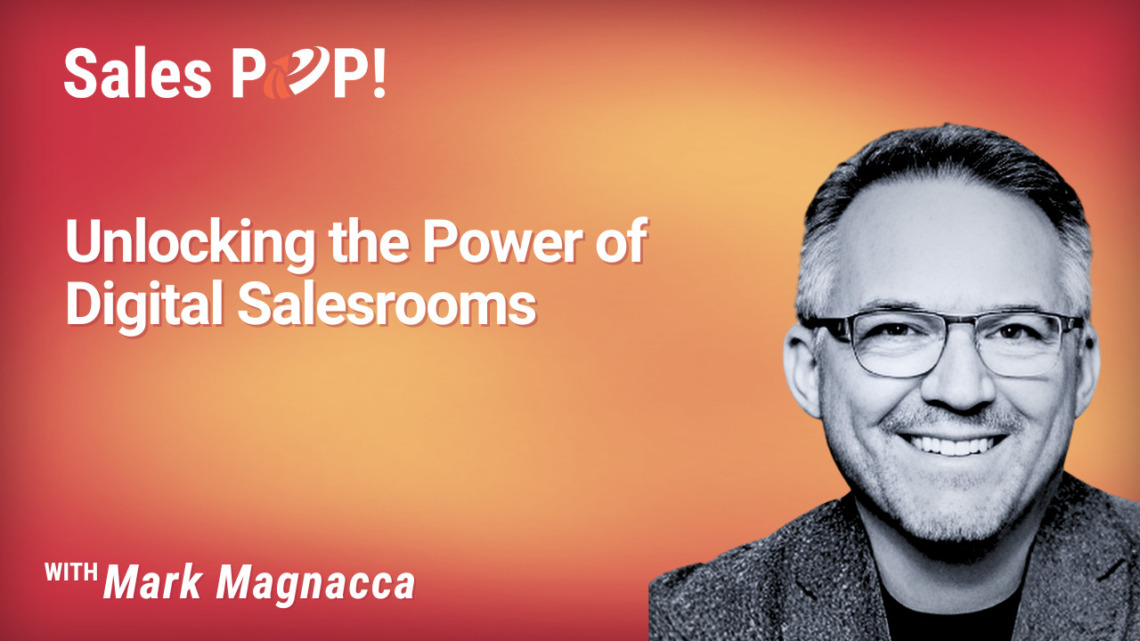In the latest episode of the expert interview series hosted by John Golden from Sales Pop Online Sales Magazine and Pipeliner CRM, we delve into the transformative concept of the “digital salesroom” (DSR) with Mark Magnacca, the president and co-founder of Allego. With a rich background in sales enablement consulting and as a co-author of books on virtual selling and digital sales, Mark provides a comprehensive overview of how digital salesrooms can revolutionize the sales process.
What is a Digital Salesroom?
A digital salesroom is a personalized microsite that facilitates communication between sellers and buyers. It serves as a centralized hub where relevant content can be shared and mutual value can be aligned. This approach caters to the modern buyer’s preference for conducting extensive research before engaging with a seller. According to Gartner, buyers complete approximately 70% of their research independently, making the DSR an essential tool for presenting curated, relevant content in a user-friendly format.
Key Features of a Digital Salesroom:
- Personalized Microsite: Tailored to individual buyers or buying groups.
- Content Sharing: Organized and relevant information presented in a structured manner.
- Engagement Tracking: Insights into which content resonates most with the audience.
Content in a Digital Salesroom
Mark emphasizes the importance of relevance regarding the content included in a digital salesroom. The DSR should serve as a curated space where sellers can present pertinent information tailored to the buyer’s needs. This personalized touch enhances the buyer’s experience and allows sellers to track engagement and understand which content resonates most with their audience.
Types of Content to Include:
- Welcome Videos: Personalized greetings that guide buyers through the content.
- Product Information: Detailed descriptions, specifications, and benefits.
- Case Studies: Real-world examples showcasing the product’s effectiveness.
- Whitepapers and E-books: In-depth resources that provide valuable insights.
- Interactive Elements: Quizzes, surveys, and calculators to engage buyers.
Integration with CRM Systems
One significant advantage of digital salesrooms is their ability to integrate seamlessly with existing CRM systems. This integration allows sellers to quickly generate personalized, visually appealing and organized content packages, making it easier for buyers to navigate and engage with the information.
Benefits of CRM Integration:
- Streamlined Process: Easy customization of templates for individual buyers.
- Consistent Messaging: Ensures all communications align with the brand’s voice.
- Enhanced Tracking: Provides insights into buyer behavior and engagement.
Types of Digital Salesrooms
Mark categorizes digital salesrooms into three main types, each serving a unique purpose in the sales process:
1. Buyer Engagement DSR
This is the primary type, where individual sellers engage with either a single buyer or a buying group. The content can be either closed (accessible only to pre-approved individuals) or open (available to anyone within a specific company).
2. Relationship Management DSR
It is useful for ongoing client relationships, such as financial advisors who share updates and relevant content with clients over time. The DSR can evolve with each interaction, ensuring the information remains current and valuable.
3. Educational DSR
Particularly relevant in industries like medical devices, this type focuses on curating educational content specific to a product being used in a healthcare facility. It helps facilitate clinical education and ensures users easily access necessary information.
The Importance of Personalization
Throughout the conversation, Mark highlights the significance of personalization in the sales process. Even small gestures, including a company logo or a personalized welcome video, can significantly enhance the buyer’s experience. The goal is not to hyper-personalize every aspect but to make the buyer feel acknowledged and valued.
Tips for Effective Personalization:
- Include Buyer’s Name and Company Logo: Simple yet impactful.
- Tailor Content to Buyer’s Needs: Focus on what matters most to the buyer.
- Use Personalized Videos: Create a more engaging and human connection.
Overcoming Information Overload
In today’s content-saturated environment, buyers often feel overwhelmed by the sheer volume of information available. A well-structured digital salesroom can cut through the noise, providing organized and relevant content that positions the seller as an expert in their field. This approach simplifies the buyer’s journey and fosters trust and credibility.
Strategies to Combat Information Overload:
- Curate Content: Only include the most relevant and valuable information.
- Organize Information: Use clear headings and sections to make navigation easy.
- Provide Summaries: Offer concise overviews of detailed documents.
The Role of AI in Digital Salesrooms
As the conversation progresses, Mark discusses the increasing role of artificial intelligence in creating and managing digital salesrooms. Initially, building a DSR was a manual process, but advancements in AI have streamlined this, allowing sellers to generate up to 90% of the necessary content through templates and automated systems. This efficiency enables sellers to focus on personalization and engagement rather than administrative tasks.
AI-Driven Benefits:
- Automated Content Generation: Saves time and ensures consistency.
- Personalization at Scale: Tailors content to individual buyer preferences.
- Enhanced Analytics: Provides deeper insights into buyer behavior.
Future of Digital Salesrooms
Mark envisions digital salesrooms becoming a standard practice across various industries. He likens the adoption of DSRs to the early days of the iPod, where the benefits became apparent only after users experienced the product. As more organizations recognize the advantages of digital salesrooms over traditional email communication, Mark believes they will become integral to the sales process.
Predictions for the Future:
- Widespread Adoption: More industries will embrace DSRs as a standard practice.
- Enhanced Features: Continuous improvements in AI and personalization capabilities.
- Greater Buyer Engagement: Increased focus on creating meaningful buyer experiences.
Real-World Applications
Mark shares a case study involving a large medical device company successfully implementing digital salesrooms. By organizing templates by market and ensuring consistent messaging, the company shifted focus from selling individual products to presenting comprehensive solutions. This strategic use of DSRs improved internal communication and enhanced the overall buyer experience.
Key Takeaways from the Case Study:
- Template Organization: Streamlined content creation and ensured consistency.
- Solution-Focused Approach: Shifted from product-centric to solution-centric selling.
- Improved Buyer Experience: Enhanced engagement and satisfaction.
Conclusion
In closing, Mark emphasizes that Allego is an enablement platform designed to support sellers throughout their journey, from onboarding to product launches and digital selling. He encourages listeners to explore the potential of digital salesrooms as a critical component of their digital transformation efforts. As organizations adapt to the evolving sales landscape, embracing tools like DSRs will be essential for staying competitive and meeting the needs of modern buyers.
John wraps up the episode by urging listeners to consider their digital transformation journeys, highlighting the importance of staying ahead in an increasingly digital world. He thanks Mark for his insights and encourages the audience to explore the resources provided in the episode.
By understanding and implementing the strategies discussed in this episode, sellers can leverage digital salesrooms to enhance buyer engagement, streamline the sales process, and ultimately drive better sales outcomes.
Our Host
John is the Amazon bestselling author of Winning the Battle for Sales: Lessons on Closing Every Deal from the World’s Greatest Military Victories and Social Upheaval: How to Win at Social Selling. A globally acknowledged Sales & Marketing thought leader, speaker, and strategist, he has conducted over 1500 video interviews of thought leaders for Sales POP! online sales magazine & YouTube Channel and for audio podcast channels where Sales POP! is rated in the top 2% of most popular shows out of 3,320,580 podcasts globally, ranked by Listen Score. He is CSMO at Pipeliner CRM. In his spare time, John is an avid Martial Artist.









Comments